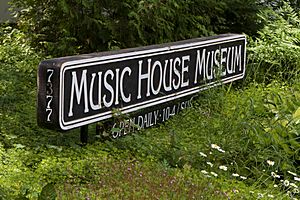Music House Museum facts for kids
The Music House Museum is a special place in Northern Michigan. It has a huge collection of old musical instruments. You can also see early radios and recordings there. The museum is located in two old farm buildings. One is a dairy barn from 1909, and the other is a farmhouse from 1905. It's found between the towns of Acme and Williamsburg in Grand Traverse County, Michigan. The museum first opened in 1983. It started because an architect and an engineer loved collecting old music items.
How the Museum Started
In the 1970s, David Stiffler, an architect, and Dean Junker, an engineer, began a fun hobby. They collected and fixed up old musical instruments. They kept their growing collection at the old Stiffler family farm. This farm was near Traverse City, Michigan.
By 1979, they had so many cool instruments. They decided to create a proper place to show them off. They formed a group called D and D Enterprises. Their goal was to collect, restore, and display these amazing musical items. They started working on the old farm buildings. They turned the 1909 dairy barn and the 1905 farmhouse into display areas.
The first part of the museum opened in mid-1983. This was in the old farmhouse, which they called the granary. It showed off historical mechanical musical instruments. After that, they started working on the big white dairy barn. It was about 12,000 square feet!
The Music House Museum officially opened to the public in May 1984. It became a non-profit organization. The main collection of restored instruments is in the white barn. The granary building is now the museum's main entrance. It also displays many old radios. A covered walkway was built in 1981. This path connects the granary entrance to the barn. The museum got its "house" name from the old farmhouse. This was where farm workers used to live and sleep.
What You Can See Today
The Music House Museum offers both guided and self-guided tours. You can learn about the history of the instruments. You will also see the amazing craftsmanship that went into them. About 20,000 people visit the museum every year. Since it opened, over half a million visitors have explored its collections.
The museum has grown a lot over the years. It displays musical items from the 1780s all the way to the 1950s. You can find unique, restored automated musical instruments. There are also player pianos and music boxes. You'll see keyboard instruments and even a mechanical violin. The museum also has antique radios, old vinyl records, and printed music.
Sometimes, the museum holds demonstrations. They show how the restored musical instruments work. Imagine seeing a huge organ from Detroit's old Cinderella Theatre! There's also a 1924 Wurlitzer theatre organ. Another amazing piece is the 97-key Amaryllis Mortier dance organ. This giant instrument is 30 feet wide and 18 feet high!
Gallery








